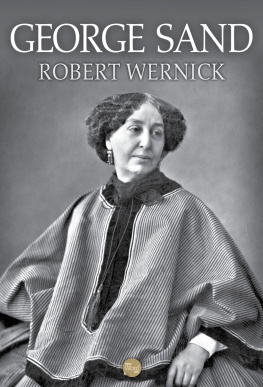GEORGE SAND AND
FREDERICK CHOPIN
IN MAJORCA
In this fascinating book, the writer George Sand recounts the story of her 1838 winter in Majorca, a winter she passed in the company of Frederick Chopin. In it she describes the natural beauties of Majorca as well as the rumblings of approaching war. A preface by Luis Ripoll, an expert on the lives of Chopin and Sand, helps the reader to appreciate the significance of this unique work.
WWW.KEGANPAUL.COM
THE KEGAN PAUL TRAVELLERS SERIES
Editorial Advisor
Peter Hopkins
A Journey Through Persia and Turkish Armenia Gerald Reitlinger
A Summer in Touraine Frederic Lees
George Sand & Frederick Chopin in Majorca George Sand
A Woman in the Balkans Winifred Gordon
Adventure in Hawaii and Tahiti Edward T. Perkins
Alexandria: The Ancient and Modern Town E. Breccia
Autobiography of a Chinese Girl Hsieh Ping-Ying
Two Vagabonds in Languedoc Jan Gordon and Cora J. Gordon
Burma R. Talbot Kelly
Chinese Pictures J. F. Bishop
Egypt and Nubia J. A. St. John
Fifty Years in Maoriland James T. Pinfold
In Hawaii with Jack London Jack London
In Stevenson's Samoa Marie Fraser
Island Nights' Entertainments Robert Louis Stevenson
Man and Animals in the New Hebrides John R. Baker
Mongolia N. Prejevalsky
My Consulate in Samoa William B. Churchward
News from Tartary Peter Fleming
Oceania Frank Fox
Unbeaten Tracks in Japan Isabella Lucy Bird
Old Touraine Theodore Andrea Cook
The Discovery of Tahiti George Robertson
The French Riviera Pierre Devoluy and Pierre Borel
The Golden Chersonese Isabella Lucy Bird
The Heart of the Orient Michael Myers Shoemaker
The Riviera Hugh Macmillan
The Romance of Treasure Trove Charles R. Beard
To Lhasa in Disguise William Montgomery McGovern
Treasure of Ophir C. E. V. Craufurd
A Year Amongst the Persians Edward Granville Browne
Constantinople and Istanbul Old and New H. G. Dwight
Tahiti George Calderon
Cruise of the Snark Jack London
In the South Seas Robert Louis Stevenson
Six Months in Hawaii Isabella Bird
Korea and Her Neighbours Isabella Bird
Strolling Through Istanbul H. Sumner-Boyd and J. Freely
Camp Life and Sport in Dalmatia and the Herzegovina Anonymous
Quest for Sheba Norman Stone Pearn and Vernon Barlow
An English Consul in Siam W. A. R. Wood
South Sea Idyls Charles Warren Stoddard
Hawaii: The Past, Present and Future of its Island-Kingdom Gerald Manly Hopkins
GEORGE SAND AND
FREDERICK CHOPIN
IN MAJORCA
BY
GEORGE SAND

Kegan Paul
London New York Bahrain
First published in 2005 by
Kegan Paul Limited
UK: P.O. Box 256, London WC1B 3SW, England
Tel: 020 7580 5511 Fax: 020 7436 0899
E-Mail:
Internet: http://www.keganpaul.com
USA: 61 West 62nd Street, New York, NY 10023
Tel: (212) 459 0600 Fax: (212) 459 3678
Internet: http://www.columbia.edu/cu/cup
BAHRAIN:
Distributed by:
Extenza-Turpin Distribution
Stratton Business Park
Pegasus Drive
Biggleswade
SG18 8QB
United Kingdom
Tel: (01767) 604951 Fax: (01767) 601640
Email:
Columbia University Press
61 West 62nd Street, New York, NY 10023
Tel: (212) 459 0600 Fax: (212) 459 3678
Internet: http://www.Columbia.edu/cu/cup
Kegan Paul, 2005
Printed in Great Britain
All Rights reserved. No part of this book may be reprinted or reproduced or utilised in any form or by any electric, mechanical or other means, now known or hereafter invented, including photocopying or recording, or in any information storage or retrieval system, without permission in writing from the publishers.
ISBN: 0-7103-1040-4
British Library Cataloguing in Publication Data
Library of Congress Cataloging-in-Publication Data
Applied for.
Preface
A FEW BACKGROUND WORDS
I think it is interesting and almost obligatory, out of consideration for the reader, to include in the explicit pages of the present book, words in the original French of Un Hiver Majorque, which we could describe as words of circumambience and clarification. This we can justify by the very nature of the work, by its descriptive rather than its narrative character, by the superficiality and even the arrangement of some of the chapters, as well as by its subjectivity which leads the authoress at times to make cutting, doubtful or false asseverations, and to divulge ideas which with the passing of time have merited a different and even contrary qualification. In my opinion, this additional touch will, I think, be well received by the reader who makes contact, perhaps for the first time, with the romantic writer; and especially if, besides, he becomes acquainted with Majorca through these same pages, or wishes to compare his own impressions of the island with those of Aurora Dupin, alias Madame Dudevant, and George Sand in her literary works.
On the other hand an attempt has also been made to avoid an excessive number of notes, combining my own with the already numerous notes of the authoress and the translator.
The first thing you should be told is that the winter to which the hook refers is the famous one of 18381839. In reality it was not a winter, but part of the autumn and a little more than half of the following season. A particular note should be made of this point, because the authoress herself, in the work we are prefacing, is mistaken; she is under the impression that she was in the island a month longer then she actually was.
We know of course all about those remote days which witnessed the visit of this early tourist from the 11th November 1838 to the 13th February 1839. We must say at once that George Sand did not make the journey alone. She was accompanied by Frederick Chopin, the immortal musician, her children, Maurice and Solange Dudevant, as well as by a French maid. The latter is presented to us as a shadowy figure, but nevertheless she played a quite important role during the travellers' Majorcan days.
The scene of their stay was first, Palma (which, contrary to what the authoress states, was formerly called Ciutat de Mallorques until the 17th century), then a house in a suburb of the capital called Establiments, and finally, from the 15th December until their departure, the Carthusian monastery (Cartuja) of Jesus the Nazarene in Valldemosa. The monks had abandoned this monastery, not of their own desire, but following a governmental law called the Ley Mendizbal; which must have been of a tremendously advanced nature for those days, and which was designed to take away or, at least, reduce the power and multiple riches that the ordinary religious Orders had succeeded unlawfully in retaining. Under this law, which was put into force at different periods, the dissolution of the Order was brought about and either the demolition of their convent, or only its secularization. An example, among several others, of the first case is the demolition of the convent of Santo Domingo, situated close to the Cathedral of Majorca, a Gothic gem, whose blessed and moving ruins the writer of this book was still able to gaze upon. And an example of the second case is the Cartuja of Valldemosa and its monks.














